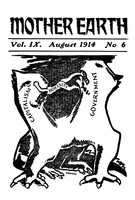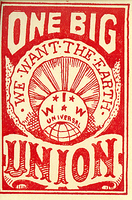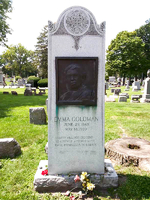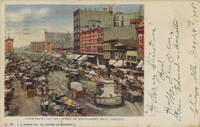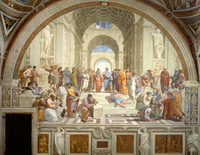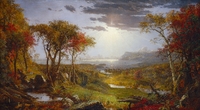Items
-
 Haymarket Riot-Harpers.jpg - Wikipedia black and white photograph
Haymarket Riot-Harpers.jpg - Wikipedia black and white photograph -
 School of Athens The Stanza della segnatura ("Room of the Signatura") was the first to be decorated by Raphael's frescoes. It was the study housing the library of Julius II, and the council chamber for the Apostolic Signatura, where most of the important papal documents were signed and sealed. The artist's concept brings into harmony the spirits of Antiquity and Christianity and reflects the contents of the pope's library with themes of theology (the Disputa, west wall), philosophy (School of Athens, east wall), jurisprudence, and the poetic arts (Parnassus, north wall). The theme of this room is worldly and spiritual wisdom and the harmony which Renaissance humanists perceived between Christian teaching and Greek philosophy. Toward the end of 1509, Raphael began work on the east wall. This second painting, entitled The School of Athens, represents the degrees of knowledge or the truth acquired through reason. Tradition holds that many of the philosophers, mathematicians and scientists are portraits of Raphael's contemporaries and that he included a self-portrait as well.
School of Athens The Stanza della segnatura ("Room of the Signatura") was the first to be decorated by Raphael's frescoes. It was the study housing the library of Julius II, and the council chamber for the Apostolic Signatura, where most of the important papal documents were signed and sealed. The artist's concept brings into harmony the spirits of Antiquity and Christianity and reflects the contents of the pope's library with themes of theology (the Disputa, west wall), philosophy (School of Athens, east wall), jurisprudence, and the poetic arts (Parnassus, north wall). The theme of this room is worldly and spiritual wisdom and the harmony which Renaissance humanists perceived between Christian teaching and Greek philosophy. Toward the end of 1509, Raphael began work on the east wall. This second painting, entitled The School of Athens, represents the degrees of knowledge or the truth acquired through reason. Tradition holds that many of the philosophers, mathematicians and scientists are portraits of Raphael's contemporaries and that he included a self-portrait as well. -
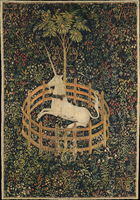 Unicorn in Captivity The Unicorn in Captivity may have been created as a single image rather than part of a series. In this instance, the unicorn probably represents the beloved tamed. He is tethered to a tree and constrained by a fence, but the chain is not secure and the fence is low enough to leap over: The unicorn could escape if he wished. Clearly, however, his confinement is a happy one, to which the ripe, seed-laden pomegranates in the tree--a medieval symbol of fertility and marriage--testify. Metropolitan Museum of Art [website]; http://www.metmuseum.org (accessed 5/30/2009)
Unicorn in Captivity The Unicorn in Captivity may have been created as a single image rather than part of a series. In this instance, the unicorn probably represents the beloved tamed. He is tethered to a tree and constrained by a fence, but the chain is not secure and the fence is low enough to leap over: The unicorn could escape if he wished. Clearly, however, his confinement is a happy one, to which the ripe, seed-laden pomegranates in the tree--a medieval symbol of fertility and marriage--testify. Metropolitan Museum of Art [website]; http://www.metmuseum.org (accessed 5/30/2009) -
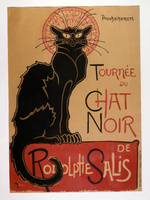 Chat Noir [inscribed, true, fr]
Poster of a Black Cat, for the Reopening of the Chat Noir Cabaret [descriptive, false, en] [This poster is offset lithography, but mass-produced and commercially printed.] Steinlen's poster advertises the reopening of a cabaret, the Chat Noir in Montmartre. Here the artist worked with several actors to present avant-garde shadow theater, which investigated the artistic and dramatic effects of silhouettes, starring R. Salis as the popular, improvisational narrator ("bonimenteur") of each shadow performance. CCO (Cataloging Cultural Objects) Catalog Examples; http://www.vrafoundation.org/ccoweb/cco/examplesindex.html (accessed 5/31/2009) [description source]
Chat Noir [inscribed, true, fr]
Poster of a Black Cat, for the Reopening of the Chat Noir Cabaret [descriptive, false, en] [This poster is offset lithography, but mass-produced and commercially printed.] Steinlen's poster advertises the reopening of a cabaret, the Chat Noir in Montmartre. Here the artist worked with several actors to present avant-garde shadow theater, which investigated the artistic and dramatic effects of silhouettes, starring R. Salis as the popular, improvisational narrator ("bonimenteur") of each shadow performance. CCO (Cataloging Cultural Objects) Catalog Examples; http://www.vrafoundation.org/ccoweb/cco/examplesindex.html (accessed 5/31/2009) [description source] -
 Consecration of the Emperor Napoleon and the Coronation of Empress Joséphine on December 2, 1804 Jacques Louis David was commissioned by Napoleon I to paint this huge canvas which depicts the splendor of the emperor’s Coronation while conveying its political and symbolic message. The painter himself was present at the ceremony, and once back in his studio portrayed the colorful congregation with realism, combining accuracy with artistry while also complying with the Emperor’s instructions. He made exhaustive preliminary studies for all the personages to be shown and enlisted the help of Ignace-Eugène-Marie Degotti (died 1824), a scene painter from the Paris Opéra, for difficulties he encountered with perspective.
Consecration of the Emperor Napoleon and the Coronation of Empress Joséphine on December 2, 1804 Jacques Louis David was commissioned by Napoleon I to paint this huge canvas which depicts the splendor of the emperor’s Coronation while conveying its political and symbolic message. The painter himself was present at the ceremony, and once back in his studio portrayed the colorful congregation with realism, combining accuracy with artistry while also complying with the Emperor’s instructions. He made exhaustive preliminary studies for all the personages to be shown and enlisted the help of Ignace-Eugène-Marie Degotti (died 1824), a scene painter from the Paris Opéra, for difficulties he encountered with perspective. -
 Autumn - On the Hudson River This monumental view of the Hudson River Valley was painted from memory in the artist's London studio. Cropsey adopted a high vantage point, looking southeast toward the distant Hudson River and the flank of Storm King Mountain. A small stream leads from the foreground, where three hunters and their dogs gaze into the sunlight. All along the meandering tributary there are signs of man's peaceful coexistence with nature: a small log cabin, grazing sheep, children playing on a bridge, and cows standing placidly in the water. Here, man neither conquers nor is subservient to nature; both coexist harmoniously. In fact, the landscape is depicted as a ready arena for further agricultural expansion. Cropsey's painting is a celebration of American nationalism. National Gallery of Art, Washington [website]; http://www.nga.gov/home.htm (accessed 5/30/2009)
Autumn - On the Hudson River This monumental view of the Hudson River Valley was painted from memory in the artist's London studio. Cropsey adopted a high vantage point, looking southeast toward the distant Hudson River and the flank of Storm King Mountain. A small stream leads from the foreground, where three hunters and their dogs gaze into the sunlight. All along the meandering tributary there are signs of man's peaceful coexistence with nature: a small log cabin, grazing sheep, children playing on a bridge, and cows standing placidly in the water. Here, man neither conquers nor is subservient to nature; both coexist harmoniously. In fact, the landscape is depicted as a ready arena for further agricultural expansion. Cropsey's painting is a celebration of American nationalism. National Gallery of Art, Washington [website]; http://www.nga.gov/home.htm (accessed 5/30/2009) -
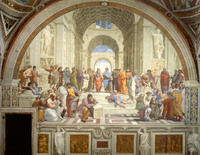 School of Athens The Stanza della segnatura ("Room of the Signatura") was the first to be decorated by Raphael's frescoes. It was the study housing the library of Julius II, and the council chamber for the Apostolic Signatura, where most of the important papal documents were signed and sealed. The artist's concept brings into harmony the spirits of Antiquity and Christianity and reflects the contents of the pope's library with themes of theology (the Disputa, west wall), philosophy (School of Athens, east wall), jurisprudence, and the poetic arts (Parnassus, north wall). The theme of this room is worldly and spiritual wisdom and the harmony which Renaissance humanists perceived between Christian teaching and Greek philosophy. Toward the end of 1509, Raphael began work on the east wall. This second painting, entitled The School of Athens, represents the degrees of knowledge or the truth acquired through reason. Tradition holds that many of the philosophers, mathematicians and scientists are portraits of Raphael's contemporaries and that he included a self-portrait as well. Wikipedia; http://en.wikipedia.org/ (accessed 12/16/2013)
School of Athens The Stanza della segnatura ("Room of the Signatura") was the first to be decorated by Raphael's frescoes. It was the study housing the library of Julius II, and the council chamber for the Apostolic Signatura, where most of the important papal documents were signed and sealed. The artist's concept brings into harmony the spirits of Antiquity and Christianity and reflects the contents of the pope's library with themes of theology (the Disputa, west wall), philosophy (School of Athens, east wall), jurisprudence, and the poetic arts (Parnassus, north wall). The theme of this room is worldly and spiritual wisdom and the harmony which Renaissance humanists perceived between Christian teaching and Greek philosophy. Toward the end of 1509, Raphael began work on the east wall. This second painting, entitled The School of Athens, represents the degrees of knowledge or the truth acquired through reason. Tradition holds that many of the philosophers, mathematicians and scientists are portraits of Raphael's contemporaries and that he included a self-portrait as well. Wikipedia; http://en.wikipedia.org/ (accessed 12/16/2013) -
 Unicorn in Captivity The Unicorn in Captivity may have been created as a single image rather than part of a series. In this instance, the unicorn probably represents the beloved tamed. He is tethered to a tree and constrained by a fence, but the chain is not secure and the fence is low enough to leap over: The unicorn could escape if he wished. Clearly, however, his confinement is a happy one, to which the ripe, seed-laden pomegranates in the tree--a medieval symbol of fertility and marriage--testify. Metropolitan Museum of Art [website]; http://www.metmuseum.org (accessed 5/30/2009)
Unicorn in Captivity The Unicorn in Captivity may have been created as a single image rather than part of a series. In this instance, the unicorn probably represents the beloved tamed. He is tethered to a tree and constrained by a fence, but the chain is not secure and the fence is low enough to leap over: The unicorn could escape if he wished. Clearly, however, his confinement is a happy one, to which the ripe, seed-laden pomegranates in the tree--a medieval symbol of fertility and marriage--testify. Metropolitan Museum of Art [website]; http://www.metmuseum.org (accessed 5/30/2009) -
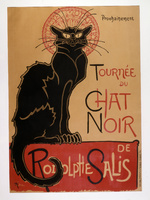 Chat NoirPoster of a Black Cat, for the Reopening of the Chat Noir Cabaret [descriptive, false, en] [This poster is offset lithography, but mass-produced and commercially printed.] Steinlen's poster advertises the reopening of a cabaret, the Chat Noir in Montmartre. Here the artist worked with several actors to present avant-garde shadow theater, which investigated the artistic and dramatic effects of silhouettes, starring R. Salis as the popular, improvisational narrator ("bonimenteur") of each shadow performance. CCO (Cataloging Cultural Objects) Catalog Examples; http://www.vrafoundation.org/ccoweb/cco/examplesindex.html (accessed 5/31/2009) [description source] | Main caption: Prochainement la très illustre Compagnie du Chat Noir avec ses Pièces d'Ombres Célèbres, ses Poëtes ses Compositeurs Avec Rodolphe Salis. Steinlen logo on bottom left. On right side: Imp. Charles Verneau, 114, Rue Oberkampf, Paris
Chat NoirPoster of a Black Cat, for the Reopening of the Chat Noir Cabaret [descriptive, false, en] [This poster is offset lithography, but mass-produced and commercially printed.] Steinlen's poster advertises the reopening of a cabaret, the Chat Noir in Montmartre. Here the artist worked with several actors to present avant-garde shadow theater, which investigated the artistic and dramatic effects of silhouettes, starring R. Salis as the popular, improvisational narrator ("bonimenteur") of each shadow performance. CCO (Cataloging Cultural Objects) Catalog Examples; http://www.vrafoundation.org/ccoweb/cco/examplesindex.html (accessed 5/31/2009) [description source] | Main caption: Prochainement la très illustre Compagnie du Chat Noir avec ses Pièces d'Ombres Célèbres, ses Poëtes ses Compositeurs Avec Rodolphe Salis. Steinlen logo on bottom left. On right side: Imp. Charles Verneau, 114, Rue Oberkampf, Paris -
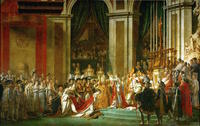 Consecration of the Emperor Napoleon and the Coronation of Empress Joséphine on December 2, 1804 Jacques Louis David was commissioned by Napoleon I to paint this huge canvas which depicts the splendor of the emperor’s Coronation while conveying its political and symbolic message. The painter himself was present at the ceremony, and once back in his studio portrayed the colorful congregation with realism, combining accuracy with artistry while also complying with the Emperor’s instructions. He made exhaustive preliminary studies for all the personages to be shown and enlisted the help of Ignace-Eugène-Marie Degotti (died 1824), a scene painter from the Paris Opéra, for difficulties he encountered with perspective. Grove Art Online; http://www.oxfordartonline.com (accessed 5/22/2014)
Consecration of the Emperor Napoleon and the Coronation of Empress Joséphine on December 2, 1804 Jacques Louis David was commissioned by Napoleon I to paint this huge canvas which depicts the splendor of the emperor’s Coronation while conveying its political and symbolic message. The painter himself was present at the ceremony, and once back in his studio portrayed the colorful congregation with realism, combining accuracy with artistry while also complying with the Emperor’s instructions. He made exhaustive preliminary studies for all the personages to be shown and enlisted the help of Ignace-Eugène-Marie Degotti (died 1824), a scene painter from the Paris Opéra, for difficulties he encountered with perspective. Grove Art Online; http://www.oxfordartonline.com (accessed 5/22/2014)
